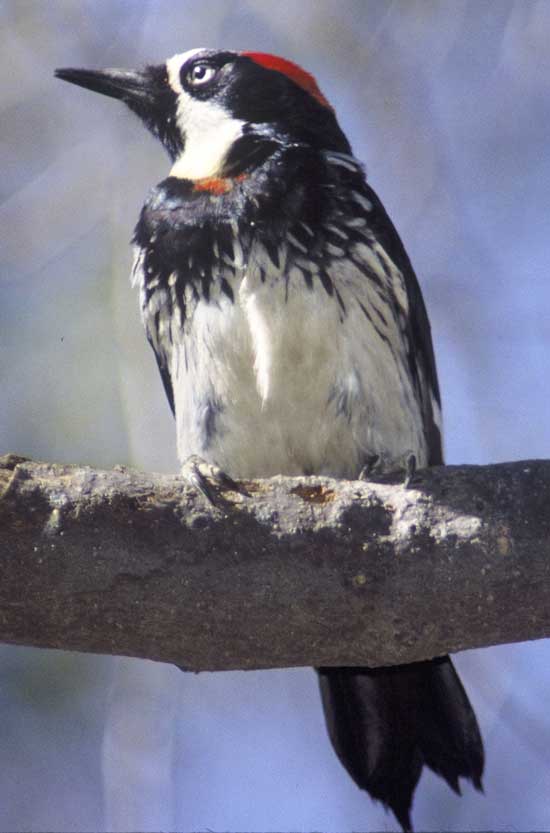Melanerpes formicivorus, Photo: U.S. Fish and Wildlife Service Cladus: Eukaryota Name Melanerpes formicivorus (Swainson, 1827) Reference The Philosophical Magazine. New Series 1 p.439 Vernacular names
The Acorn woodpecker (Melanerpes formicivorus) is a medium-sized woodpecker, 21 cm long with an average weight of 85 g. The adult has a black head, back, wings and tail, white forehead, throat, belly and rump. The eyes are white. The adult male has a red cap starting at the forehead, whereas females have a black area between the forehead and the cap. The white neck, throat and forehead patches are distinctive identifiers. Breeding communities The breeding habitat is forested areas with oaks in the hills of coastal California and the southwestern United States south to Colombia. This species may occur at low elevations in the north of its range, but rarely below 1000m in Central America, and it breeds up to the timberline. The breeding pair excavate a nest in a large cavity in a dead tree or a dead part of a tree. A group of adults may participate in nesting activities: Field studies have shown that breeding groups range from monogamous pairs to breeding collectives of seven males and three females, plus up to 10 nonbreeding helpers. Young have been found with multiple paternity.[1] Food and homes Acorn woodpeckers, as their name implies, depend heavily on acorns for food. In some parts of their range (e.g., California), the woodpeckers create granaries or "acorn trees" by drilling holes in dead trees, dead branches, telephone poles and wooden buildings. The woodpeckers then collect acorns and find a hole that is just the right size for the acorn. As acorns dry out, they are moved to smaller holes and granary maintenance requires a significant amount of the bird's time. They also feed on insects, sap, and fruit. Defense and storing The acorns are visible, and the group defends the tree against potential cache robbers like Steller's Jays and Western Scrub Jays. Acorns are such an important resource to the California populations that Acorn Woodpeckers may nest in the fall to take advantage of the fall acorn crop, a rare behavior in birds [2]. Acorn Woodpeckers can also be seen sallying from tree limbs to catch insects, eating fruit and seeds, and drilling holes to drink sap. The Acorn Woodpecker will use any human-made structures to store acorns, drilling holes into fence posts, utility poles, buildings, and even automobile radiators. Occasionally the woodpecker will put acorns into places where it cannot get them out. Woodpeckers put 220 kg (485 lb) of acorns into a wooden water tank in Arizona. In parts of its range the Acorn Woodpecker does not construct a granary tree, but instead stores acorns in natural holes and cracks in bark. If the stores are eaten, the woodpecker will move to another area, even going from Arizona to Mexico to spend the winter. Breeding behavior In California, Acorn Woodpeckers breed from April – June. An Acorn Woodpecker group may consist of 1-7 male breeders that compete to mate with 1-3 females. The nest is excavated in a large tree, which may also be a granary tree. Tree cavities are created in both dead and living trees and snags and nest holes are reused for many years. Females typically lay 5 eggs that are incubated for 11–14 days. Male and females incubate and tend to their young. Non-breeding helpers (young from previous years) often help with incubation and other parental duties. The young leave the nest and take their first flight at approximately 30–32 days after hatching and return to the nest to be fed for several weeks.
This bird is a permanent resident throughout its range. They may relocate to another area if acorns are not readily available. It is sedentary and very sociable. Threats and degradation
Popular culture Walter Lantz is believed to have patterned the call of his cartoon character Woody Woodpecker on that of the acorn woodpecker, while patterning his appearance on that of the Pileated Woodpecker which has a prominent crest.[3] Notes 1. ^ Joste, N., Ligon, D., and Stacey, P. (1985) Behavioral Ecology and Sociobiology; Behavioral Ecology and Sociobiology 17(1):39-41
* BirdLife International (2004). Melanerpes formicivorus. 2006. IUCN Red List of Threatened Species. IUCN 2006. www.iucnredlist.org. Retrieved on 10 May 2006. Database entry includes justification for why this species is of least concern
Source: Wikipedia, Wikispecies: All text is available under the terms of the GNU Free Documentation License |
|

